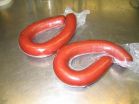Rules of thumb: 3 simple ideas for overcoming childhood obesity
2014-05-01
(Press-News.org) New Orleans, LA – Kristopher Kaliebe, MD, Clinical Assistant Professor of Psychiatry at the LSU Health Sciences Center New Orleans School of Medicine, offers parents and caregivers three simple family-oriented goals to overcome the complex problem of childhood obesity and related mental disorders. They involve limit setting to address the brain's "get more" drive strengthened through habitual over-consumption of temptations including highly caloric processed food, hyper-reality media and electronics, as well as excessive sitting. His 3 "rules" of living promote physical and mental health for children and parents for both treatment and prevention. They are published in the April 2014 issue of the Journal of the American Academy of Child and Adolescent Psychiatry.
"The pediatric obesity crisis arose from systemic changes in society and multiple dynamic interacting risk factors," notes Dr. Kaliebe. "It has been paralleled by increased mental health problems that seem interrelated."
Childhood obesity correlates with attention-deficit /hyperactivity disorder, learning disorders, and academic underperformance as well as increased internalizing and externalizing disorders.
"Moreover, many behavior patterns associated with obesity, such as sedentary lifestyles, excessive media exposure, and inappropriate diets, also correlate with a psychiatric diagnosis or psychological distress," says Dr. Kaliebe.
His "rules," meant to facilitate healthy choices, are straightforward and practical.
1. Eat Food – Not too Much, Mostly Plants. Dr. Kaliebe explains that eating natural, unprocessed, raw food eliminates the constant need to calculate calories, carbohydrates, fat, protein, vitamins, etc. – a reason diets fail. This rule also advises severely restricting foods like chips, sodas and fast food.
2. Get Up and Move. Noting that humans are not built to sit for much of the day, Dr. Kaliebe says children as well as parents need to find excuses to move whenever possible and be especially active during leisure time.
3. Honor Silence. Dr. Kaliebe says sensory overload and "noise" from popular culture, gaming, advertising, media and electronics crowds out important things such as family matters, academics, sleep, and the development of other interests.
"Habits have profound effects," concludes Dr. Kaliebe. "Celebrations, such as birthday parties, are less meaningful. Don't stress over the occasional special treat, but be strict about everyday routines."
INFORMATION:
LSU Health Sciences Center New Orleans educates Louisiana's health care professionals. The state's most comprehensive health university, LSUHSC includes a School of Medicine, the state's only School of Dentistry, Louisiana's only public School of Public Health, and Schools of Allied Health Professions, Nursing, and Graduate Studies. While teaching each new generation of health care professionals, LSUHSC faculty take care of patients in public and private hospitals and clinics throughout the region. In the vanguard of biosciences research in a number of areas in a worldwide arena, the LSUHSC research enterprise generates jobs and enormous economic impact. LSUHSC faculty have made lifesaving discoveries and continue to work to prevent, advance treatment, or cure disease. To learn more, visit http://www.lsuhsc.edu, http://www.twitter.com/LSUHSCHealth or http://www.facebook.com/LSUHSC.
ELSE PRESS RELEASES FROM THIS DATE:
Individual brain activity predicts tendency to succumb to daily temptations
2014-05-01
Activity in areas of the brain related to reward and self-control may offer neural markers that predict whether people are likely to resist or give in to temptations, like food, in daily life, according to research in Psychological Science, a journal of the Association for Psychological Science.
"Most people have difficulty resisting temptation at least occasionally, even if what tempts them differs," say psychological scientists Rich Lopez and Todd Heatherton of Dartmouth College, authors on the study. "The overarching motivation of our work is to understand why some ...
Antimicrobial edible films inhibit pathogens in meat
2014-05-01
Antimicrobial agents incorporated into edible films applied to foods to seal in flavor, freshness and color can improve the microbiological safety of meats, according to researchers in Penn State's College of Agricultural Sciences.
Using films made of pullulan -- an edible, mostly tasteless, transparent polymer produced by the fungus Aureobasidium pulluns -- researchers evaluated the effectiveness of films containing essential oils derived from rosemary, oregano and nanoparticles against foodborne pathogens associated with meat and poultry.
The results demonstrate that ...
Researchers find the accelerator for molecular machines
2014-05-01
How hard can it be to make a wheel rotate in a machine? Very hard actually, when the wheel sits in one of those nano-small molecular machines that are predicted to be running our future machines. But before the molecular machines become part of our daily lives, researchers must be able to control them. A Danish/American research team have now solved part of this problem.
There are large machines and there are small machines - and then there are molecular machines. They are nano-tiny collections of molecular building blocks that together make up a machine and operate various ...
Unlocking a mystery of thalidomide
2014-05-01
In the 1950s and 1960s, pregnant women with morning sickness were often prescribed the new drug thalidomide. Shortly after the medicine was released on the market, a reported 10,000 infants were born with an extreme form of the rare congenital phocomelia syndrome, which caused death in 50 percent of cases and severe physical and mental disabilities in others. Although various factors are now known to cause phocomelia, the prominent roots of the disease can be found in the use of the drug thalidomide.
Now, half a century later, new research by Dr. Noam Shomron, Prof ...
New study suggests combination of statin and omega-3 fatty acid may provide cardioprotective effects
2014-05-01
Boston, MA-- New findings from an in vitro study, led by researchers at Brigham and Women's Hospital (BWH), show that the combination of statins and eicosapentaenoic acid (EPA), an omega-3 fatty acid, may potentially reduce cardiovascular risk. This research is being presented May 1 at a peer-reviewed poster session at the National Lipid Association Scientific Sessions in Orlando, Florida.
"We know that endothelial cell dysfunction is emerging as an early and important predictor of cardiovascular disease and plays an essential role in plaque development. Treatments that ...
Risk of weight gain deters some smokers from seeking treatment to quit
2014-05-01
Smokers may avoid treatment to quit smoking if they previously gained weight while trying to quit, according to researchers at Penn State College of Medicine.
Weight gain is a predictable occurrence for smokers who have recently quit. Within the first year after quitting, they gain an average of eight to14 pounds, and some smokers report that they keep smoking simply because they do not want to gain weight from quitting.
Susan Veldheer, project manager in the Department of Public Health Sciences, predicted that smokers would avoid treatment to quit if they are highly ...
Experimental drug prolongs life span in mice
2014-05-01
CHICAGO --- Northwestern Medicine® scientists have newly identified a protein's key role in cell and physiological aging and have developed – in collaboration with Tohoku University in Japan -- an experimental drug that inhibits the protein's effect and prolonged the lifespan in a mouse model of accelerated aging.
The rapidly aging mice fed the experimental drug lived more than four times longer than a control group, and their lungs and vascular system were protected from accelerated aging, the new study reports.
The experimental drug could potentially be used to treat ...
Researchers reveal new cause of epilepsy
2014-05-01
A team of researchers from SUNY Downstate Medical Center (SUNY Downstate) and Sanford-Burnham Medical Research Institute (Sanford-Burnham) has found that deficiencies in hyaluronan, also known as hyaluronic acid or HA, can lead to spontaneous epileptic seizures. HA is a polysaccharide molecule widely distributed throughout connective, epithelial, and neural tissues, including the brain's extracellular space (ECS). Their findings, published on April 30 in The Journal of Neuroscience, equip scientists with key information that may lead to new therapeutic approaches to epilepsy. ...
Algae 'see' a wide range of light
2014-05-01
VIDEO:
Land plants detect light with pigments called phytochromes, which are sensitive to red light. But red light is absorbed by water, so aquatic algae have evolved phytochromes with a much...
Click here for more information.
Aquatic algae can sense an unexpectedly wide range of color, allowing them to sense and adapt to changing light conditions in lakes and oceans. The study by researchers at UC Davis was published earlier this year in the journal Proceedings of the National ...
Climate change to intensify important African weather systems, Stanford scientists say
2014-05-01
Weather systems that bring rainstorms to many drought-prone areas of northern Africa, carry Saharan dust across the ocean and seed Atlantic hurricanes could grow stronger as a result of human-caused climate change, a new analysis by Stanford scientists suggests.
Known as African easterly waves, or AEWs, these weather systems form above northern Africa during the summer season and travel east to west, toward the Atlantic Ocean.
"Not only are AEWs important for rainfall in West Africa, they also play a role in climate across the Atlantic, including here in the United ...

